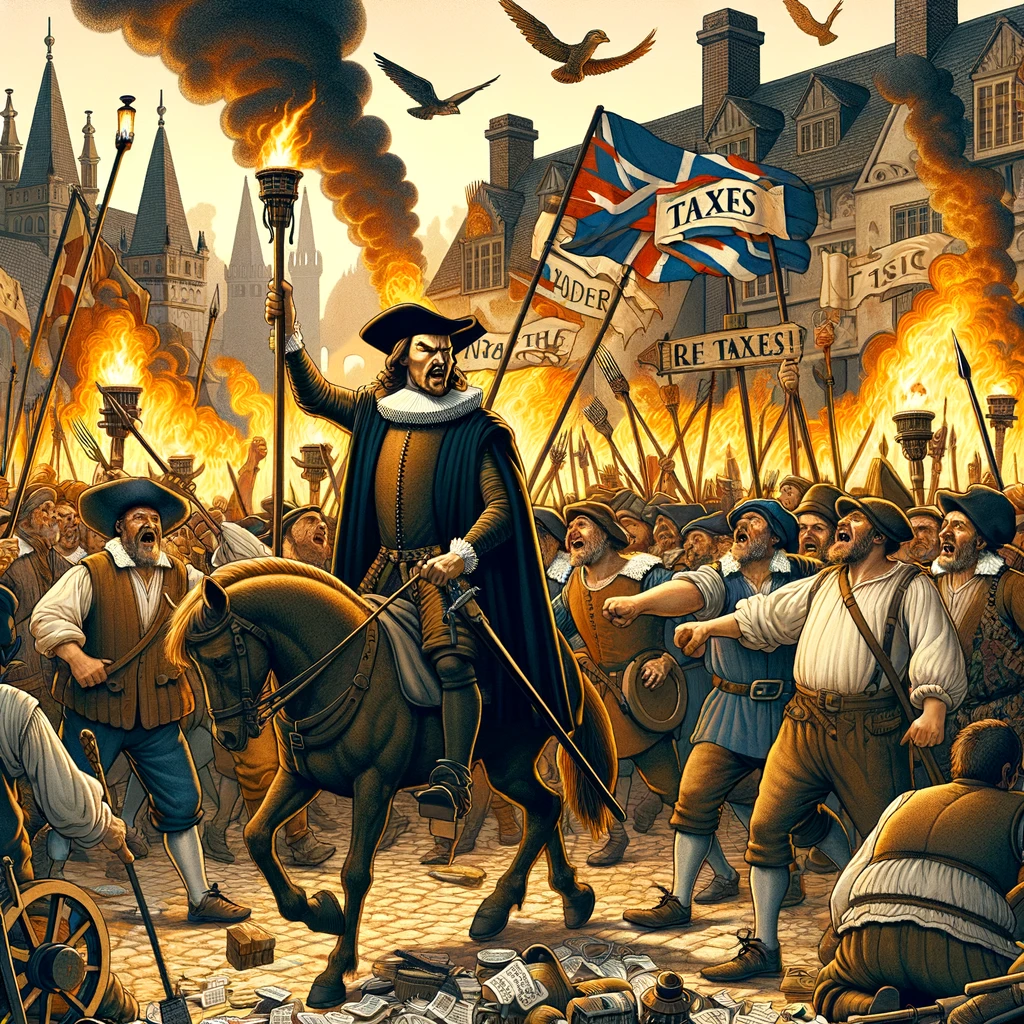
BazBudget
Read more
May 21, 2024 | 7 min read
Author: Andy Wood

Next week marks the venerable anniversary of 643 years since the start of the Peasant’s Revolt.
You know, Wat Tyler and all that.
What you didn’t know Wat?
What are they teaching in schools these days!?
They’re obviously not teaching Wat in schools these days.
That said – I do love a bit of tax history (Let’s face it, its better than the tax present… and probably the UK tax future).
Particularly when there’s a bit of gore.
And this episode had a lot of it…tax and gore.
Indeed, this period of English history is not referred to as the Summer of Blood without good reason.
The Peasants Revolt is generally accepted as beginning at the end of May 1381.
However, in a remarkable period, just one month later, whilst setting out the ‘commoner’s demands to a barely teenage king Richard II, Wat was stabbed by the Mayor of London (less excitement in the mayoral elections these days).
If you thought his day couldn’t get much worse, Tyler having been smuggled by his allies to St Bartholomew’s hospital, was found, dragged from his bed and beheaded in Smithfields.
Ouch.
Worse was in store for Tyler’s sidekick, the ‘Mad Priest of Kent’ John Ball (never ends well for Mad Priests does it?).
He was hung, beheaded, disembowelled and quartered. The remains being were dispatched to the four corners of the kingdom… possibly forming the grimmest Amazon delivery in history.
But what prompted such violent retribution.
Could it really be tax?
Well, obvs.
In 1381, Black Death had swept through Europe and had reportedly killed one-third of the continent’s population.
One third.
Of everybody.
Bearing in mind there were around 3.8m worldwide deaths from COVID from a global population of 7.8bn (0.05% of the population) then this is a staggering figure.
Practically, this left a shortage of people to work on the land.
Recognising the value of their labour, the commoner’s demanded higher wages and better conditions.
Supply and demand, innit?
But the Government, being the landowners, didn’t truck such economic sophistry.
In order to combat such impertinence, they introduced a National Maximum Wage. In addition, refusing to work for this maximum wage became an imprisonable offence.
Secondly, a poll tax was levied, for the third time in four years, to fund the long war with France.
In those days, of course, it literally was a war chest.
There was no borrowing or going to the global markets. It was a chest full of swag. Swagged from the commoners.
But the state of the country’s finances was parlous – it needed £160,000 to keep the country afloat.
But this is a pittance I hear you say. You couldn’t buy a terrace house in Warrington for that!?
Well, you probably could, but that’s besides the point.
The point is that this figure was eight times more than that which had been raised from the previous tax just two years earlier.
The proposed tax was 16d-20d per person – the equivalent to 4-5 times the daily pay of a skilled craftsman and 8-10 days for a farmhand.
Every adult (aged over 14) in a household would have to cough up – whether in work or not. It would cripple the poor.
Audits of tax receipts were undertaken.
In Essex, where only 2 years earlier, the declared population had been 48,000, the county claimed now that only 30,000 people lived there.
There had been no serious outbreaks of plague in that period so the logical conclusion was that Essex and other counties were fiddling their numbers to avoid the tax.
TOWIE in the dark ages.
The King’s Council was furious with this skulduggery and sent royal thugs out into the countryside to find out what was going on and lock up anyone who did not comply.
There were rumours of particularly harsh treatment being meted out by the tax collectors. It was rumoured that in one village a tax collector ‘shamelessly lifted the young girls’ skirts…’ to test whether they were sexually activity – which would make them liable for taxation.
An interesting means test.
One explanation for such rough treatment was that the government was effectively selling licences to collect the taxed owed and keep anything ‘extra’ for themselves!
You can almost hear today’s Government on the phone to Capita or Fujitsu to talk through about this great idea!)
The commoners of the region – Essex and Kent – began to foment a plan to resist.
The plot, it thickeneth.
Whipped up by the aforementioned John Ball (he was still in one piece at the time) – the commoners began to riot and protest.
In a co-ordinated action, the commoners of Kent (led by Tyler) and those of Essex (led by Jack Straw – not that one!) began to march on London.
Perhaps surprisingly, the commoners claimed to march in the name of their young king.
Their ire was directed at his advisers such as John O’Gaunt, a Dominic Cummings-esque character thought to have instigated the poll tax and the Archbishop of Canterbury… who would ultimately meet an ungodly end at the hands, or more accurately the axe, of the rebels.
We are told that upon reaching the outer limits of the city the draw bridge was lowered and the rebels allowed to pass into city unopposed. The rebels embarked on a rampage of destruction – mainly property relating to the law and the church.
Public enemy number one, John O’Gaunt, had his Savoy Palace residence raised to the ground.
Whilst his advisers, including the Archbishop, were holed up in the Tower of London, the increasingly concerned King met with the rebels at Mile End (it was on the Tube line).
Here, he appeared to agree to their demands.
However, and perhaps illustrating why, on balance, it is not a good idea to coronate a 10 year old, he told the rebels they were free to go across the country catching traitors who would be punished.
The rebels, with seemingly the support of their King, marched on the Tower of London and once again found little resistance from the guards.
Inside, they found the Archbishop, dragged him from his alter and beheaded him on Tower Hill as a traitor.
One and one’s big mouth.
The next day, the King asked to see Tyler at Smithfields. The young King once again acquiesced to Tyler and the rebel’s demands but ordered them to go home.
It appears that what happened next stemmed from Tyler’s ‘vulgarity’ when quenching his thirst with a jug of ale.
One of the king’s entourage, presumably patience well and truly frayed, called Tyler a thief and a robber. Tyler gripped his dagger and said the culprit would lose their head.
Lord Mayor Walworth saw his chance and, after a short scuffle, plunged his own dagger in to Tyler’s neck.
Tyler managed to mount his horse and ride away from the royal party but never made it back to the rebels.
He was taken to St Bartholomew’s hospital to have his wounds treated.
However, he was found by the King’s minions and was dragged from his bed, propped up in the field and had his head promptly chopped off.
In the melee, the King led the shocked rebels from the field and the rebels dispersed into the countryside.
The mad priest John Ball was captured and met his own grisly end one month later.
Needless to say, the King did not keep any of his promises to the commoners. Instead, he embarked on a campaign of vengeance. The ‘natural order’ being re-imposed with an iron glove and an axe….
…and probably some kind of dis-embowelling gizmo.